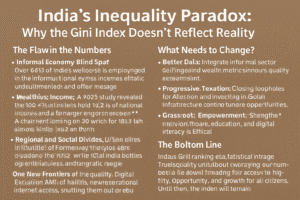India’s Inequality Paradox: Why the Gini Index Doesn’t Reflect Reality
India’s Gini Index score of 25.5—ranking it among the world’s “most equal” societies—masks a harsh reality of entrenched inequality.
The index fails because it overlooks 80% of workers in the informal economy, whose unstable incomes escape official data. Worse, it measures income alone, ignoring vast wealth gaps: the top 1% captures 22.6% of national income while chauffeurs earn ₹3 lakh annually driving ₹30 lakh cars.
Beyond traditional divides like caste and geography, new fractures emerge—digital exclusion, banking deserts, and healthcare disparities—leaving millions behind. Until assessments include informal labor, wealth concentration, and modern inequities, such rankings remain a statistical mirage.
True progress demands reimagined policies that prioritize dignity over data averages.

India’s Inequality Paradox: Why the Gini Index Doesn’t Reflect Reality
At first glance, India’s Gini Index score of 25.5—placing it among the world’s “most equal” societies—seems like a triumph. But for millions of Indians, this statistical victory feels disconnected from their daily struggles. The reality? India is a nation of deep and growing disparities, where wealth, opportunity, and access to basic services remain sharply divided.
The Flaw in the Numbers
The Gini Index, which measures income distribution, fails to capture India’s true inequality for several reasons:
- Informal Economy Blind Spot: Over 80% of India’s workforce is employed in the informal sector, where incomes are erratic, undocumented, and often meager. Tax data—the primary source for Gini calculations—misses this vast population, skewing results.
- Wealth vs. Income: Income inequality tells only part of the story. A 2023 study revealed that the top 1% of Indians hold 22.6% of national income and a far larger share of assets (property, stocks, etc.). A chauffeur driving a ₹30 lakh car for a ₹3 lakh annual salary isn’t an anomaly—it’s the norm.
- Regional and Social Divides: Urban elites in Mumbai or Delhi enjoy lifestyles comparable to the West, while rural India battles agrarian distress and stagnant wages. Caste, gender, and religion further compound disparities.
The New Frontiers of Inequality
Beyond traditional wealth gaps, modern India faces emerging divides:
- Digital Exclusion: 60% of Indians lack meaningful internet access, shutting them out of education, jobs, and financial services.
- Banking Inequality: Despite Jan Dhan’s success, 30% of accounts remain inactive, and rural credit access is dismal.
- Healthcare: The wealthy get world-class treatment; the poor rely on underfunded public hospitals.
What Needs to Change?
- Better Data: Policymakers must integrate informal sector earnings and wealth metrics into inequality assessments.
- Progressive Taxation: Closing loopholes for the ultra-rich and investing in social infrastructure can redistribute opportunities.
- Grassroots Empowerment: Strengthening rural healthcare, education, and digital literacy is critical.
India’s Gini ranking is a statistical mirage. True equality isn’t about averaging out numbers—it’s about ensuring fair access to dignity, opportunity, and growth for all citizens. Until then, the index will remain a misleading comfort.
You must be logged in to post a comment.